Mama Mechanics (for dads and other caregivers too!)
- Blog Mama Mechanics (for dads and other caregivers too!)
Getting onto the trail with baby is a wonderful thing! It’s good for everyone to get outside. Walking, or better yet, hiking, with my littles always raises my spirits and they love being outside. But these benefits quickly evaporate if hiking with baby is uncomfortable or even painful.
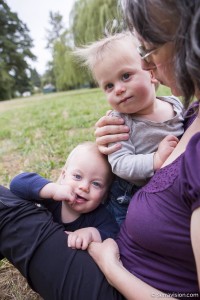 As a certified Alexander Technique teacher, I help people learn to use their bodies better. I think of the work as operating instructions for the human organism that help us improve our movement and posture, prevent (or recover from) pain and injury, and manage stress better. People often come to me and want to blame their discomfort on what they do (“I spend all day at the computer, so my shoulders are rounded.” Or “I have a really heavy toddler and lifting him makes my back hurt.”). I always try to impress upon them that it’s not what we do but how we do it that matters. So in this blog I’m going to attempt to address the mechanics of baby wearing and strollering in a way that will help you spend your time enjoying the outdoors with your baby, rather than wishing this parenting thing didn’t hurt.
Here are some dos and don’ts for hiking with baby.
With baby on the front, it’s common to try to counterbalance his weight by throwing the shoulders backward.
As a certified Alexander Technique teacher, I help people learn to use their bodies better. I think of the work as operating instructions for the human organism that help us improve our movement and posture, prevent (or recover from) pain and injury, and manage stress better. People often come to me and want to blame their discomfort on what they do (“I spend all day at the computer, so my shoulders are rounded.” Or “I have a really heavy toddler and lifting him makes my back hurt.”). I always try to impress upon them that it’s not what we do but how we do it that matters. So in this blog I’m going to attempt to address the mechanics of baby wearing and strollering in a way that will help you spend your time enjoying the outdoors with your baby, rather than wishing this parenting thing didn’t hurt.
Here are some dos and don’ts for hiking with baby.
With baby on the front, it’s common to try to counterbalance his weight by throwing the shoulders backward.
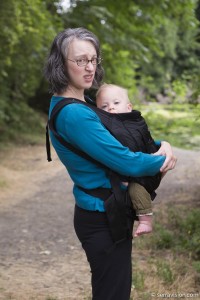
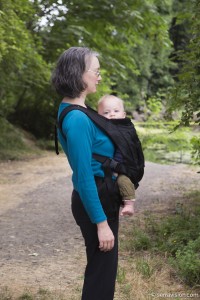 You can see this causes me to exaggerate the curve of my lower back, compressing my vertebrae. This may look familiar from pregnancy—many women deal with the extra weight in front by bending over backwards. Ouch!
Below I have found a more efficient way of counterbalancing the weight.
You can see this causes me to exaggerate the curve of my lower back, compressing my vertebrae. This may look familiar from pregnancy—many women deal with the extra weight in front by bending over backwards. Ouch!
Below I have found a more efficient way of counterbalancing the weight. 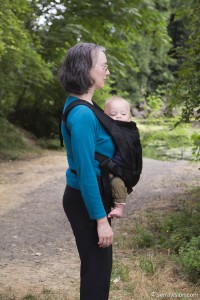 All I’ve done is bring my weight back onto my heels a bit
All I’ve done is bring my weight back onto my heels a bit 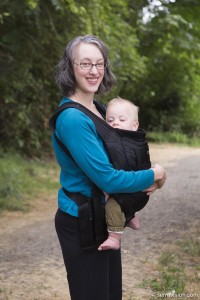 and I no longer need to bend over backwards.
See how everything is nicely stacked and supported?
and I no longer need to bend over backwards.
See how everything is nicely stacked and supported?
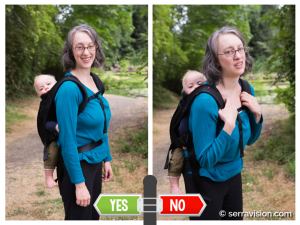 If I instead think of those amazing women who carry water and firewood on their heads, I’m able to allow the weight to heighten my dynamic postural tone. I allow my nose to drop slightly and I imagine the crown of my head releasing up and ever so slightly forward away from the weight of the baby. Bringing me into greater length. And I allow my back to spread wide against the baby.
If I instead think of those amazing women who carry water and firewood on their heads, I’m able to allow the weight to heighten my dynamic postural tone. I allow my nose to drop slightly and I imagine the crown of my head releasing up and ever so slightly forward away from the weight of the baby. Bringing me into greater length. And I allow my back to spread wide against the baby.
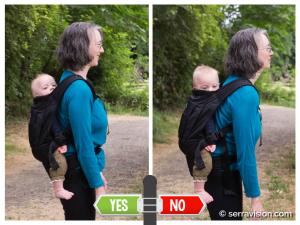 What about using a stroller? That should make things easier, right? Well, only if we push efficiently.
On the right: This stroller is heavy! I’m operating under the belief that I really need to bend forward at the waist and push with my shoulders and arms. On the left: Oh wait. If I just stand up, rest my hands lightly on the stroller (no need for a death grip) and walk forward, the stroller goes just fine, allowing my neck, upper back and shoulders to relax, while my legs do the work. Maybe I won’t need a massage following this hike after all.
What about using a stroller? That should make things easier, right? Well, only if we push efficiently.
On the right: This stroller is heavy! I’m operating under the belief that I really need to bend forward at the waist and push with my shoulders and arms. On the left: Oh wait. If I just stand up, rest my hands lightly on the stroller (no need for a death grip) and walk forward, the stroller goes just fine, allowing my neck, upper back and shoulders to relax, while my legs do the work. Maybe I won’t need a massage following this hike after all.
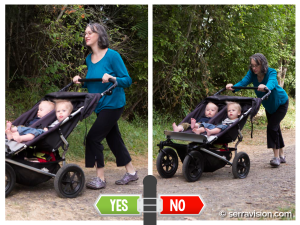 I hope these pointers help you next time you hit the trail. They may, in fact, be deceptively simple. We all know that we should stand up straight, and yet so few people seem to manage it! Why is that? The Alexander Technique was developed by a man (Frederick Matthias Alexander) who asked just that question: Why is there a disconnect between the behavior I desire and what I’m actually doing? This is where working with a certified Alexander Technique teacher comes in handy. We help our students strip away a lifetime of unhelpful (and largely unconscious) movement habits that get in the way of what we want—free, easy, poised use of our whole being.
Eve Bernfeld is a mom of triplets and a lifelong hiker living in Portland, OR. As a certified Alexander Technique teacher, she helps people unlearn their habits of poor coordination and optimize their mind-body functioning. She specializes in working with pregnant women and new moms with back pain. For more info, check out www.inbalanceat.com. To find a certified Alexander Technique teacher near you, check out http://www.amsatonline.org/teachers.
Photography by:
Serra Hadsell
Serravision Photography
http://serravision.com
From her website: "The beauty is in the details. It is the raggedy blanket. It is the toddler who insists on wearing boots and no pants. It is the way the light comes in through your kitchen window in the afternoon. It is the looks you share with those you love.
Relax and enjoy being together–Let your true family stories come alive!
I want you to look back decades from now and say 'YES! That’s exactly what our life looked like. Wasn’t it beautiful?’ "
I hope these pointers help you next time you hit the trail. They may, in fact, be deceptively simple. We all know that we should stand up straight, and yet so few people seem to manage it! Why is that? The Alexander Technique was developed by a man (Frederick Matthias Alexander) who asked just that question: Why is there a disconnect between the behavior I desire and what I’m actually doing? This is where working with a certified Alexander Technique teacher comes in handy. We help our students strip away a lifetime of unhelpful (and largely unconscious) movement habits that get in the way of what we want—free, easy, poised use of our whole being.
Eve Bernfeld is a mom of triplets and a lifelong hiker living in Portland, OR. As a certified Alexander Technique teacher, she helps people unlearn their habits of poor coordination and optimize their mind-body functioning. She specializes in working with pregnant women and new moms with back pain. For more info, check out www.inbalanceat.com. To find a certified Alexander Technique teacher near you, check out http://www.amsatonline.org/teachers.
Photography by:
Serra Hadsell
Serravision Photography
http://serravision.com
From her website: "The beauty is in the details. It is the raggedy blanket. It is the toddler who insists on wearing boots and no pants. It is the way the light comes in through your kitchen window in the afternoon. It is the looks you share with those you love.
Relax and enjoy being together–Let your true family stories come alive!
I want you to look back decades from now and say 'YES! That’s exactly what our life looked like. Wasn’t it beautiful?’ "
 As a certified Alexander Technique teacher, I help people learn to use their bodies better. I think of the work as operating instructions for the human organism that help us improve our movement and posture, prevent (or recover from) pain and injury, and manage stress better. People often come to me and want to blame their discomfort on what they do (“I spend all day at the computer, so my shoulders are rounded.” Or “I have a really heavy toddler and lifting him makes my back hurt.”). I always try to impress upon them that it’s not what we do but how we do it that matters. So in this blog I’m going to attempt to address the mechanics of baby wearing and strollering in a way that will help you spend your time enjoying the outdoors with your baby, rather than wishing this parenting thing didn’t hurt.
Here are some dos and don’ts for hiking with baby.
With baby on the front, it’s common to try to counterbalance his weight by throwing the shoulders backward.
As a certified Alexander Technique teacher, I help people learn to use their bodies better. I think of the work as operating instructions for the human organism that help us improve our movement and posture, prevent (or recover from) pain and injury, and manage stress better. People often come to me and want to blame their discomfort on what they do (“I spend all day at the computer, so my shoulders are rounded.” Or “I have a really heavy toddler and lifting him makes my back hurt.”). I always try to impress upon them that it’s not what we do but how we do it that matters. So in this blog I’m going to attempt to address the mechanics of baby wearing and strollering in a way that will help you spend your time enjoying the outdoors with your baby, rather than wishing this parenting thing didn’t hurt.
Here are some dos and don’ts for hiking with baby.
With baby on the front, it’s common to try to counterbalance his weight by throwing the shoulders backward.

 You can see this causes me to exaggerate the curve of my lower back, compressing my vertebrae. This may look familiar from pregnancy—many women deal with the extra weight in front by bending over backwards. Ouch!
Below I have found a more efficient way of counterbalancing the weight.
You can see this causes me to exaggerate the curve of my lower back, compressing my vertebrae. This may look familiar from pregnancy—many women deal with the extra weight in front by bending over backwards. Ouch!
Below I have found a more efficient way of counterbalancing the weight.  All I’ve done is bring my weight back onto my heels a bit
All I’ve done is bring my weight back onto my heels a bit  and I no longer need to bend over backwards.
See how everything is nicely stacked and supported?
and I no longer need to bend over backwards.
See how everything is nicely stacked and supported?
If my back could talk it would say, “Ah!”
When carrying weight (baby or otherwise) on our backs, we tend to slump under the weight. Don’t I look tired already in the photo below? And I haven’t even hit the trail! If I instead think of those amazing women who carry water and firewood on their heads, I’m able to allow the weight to heighten my dynamic postural tone. I allow my nose to drop slightly and I imagine the crown of my head releasing up and ever so slightly forward away from the weight of the baby. Bringing me into greater length. And I allow my back to spread wide against the baby.
If I instead think of those amazing women who carry water and firewood on their heads, I’m able to allow the weight to heighten my dynamic postural tone. I allow my nose to drop slightly and I imagine the crown of my head releasing up and ever so slightly forward away from the weight of the baby. Bringing me into greater length. And I allow my back to spread wide against the baby.
 What about using a stroller? That should make things easier, right? Well, only if we push efficiently.
On the right: This stroller is heavy! I’m operating under the belief that I really need to bend forward at the waist and push with my shoulders and arms. On the left: Oh wait. If I just stand up, rest my hands lightly on the stroller (no need for a death grip) and walk forward, the stroller goes just fine, allowing my neck, upper back and shoulders to relax, while my legs do the work. Maybe I won’t need a massage following this hike after all.
What about using a stroller? That should make things easier, right? Well, only if we push efficiently.
On the right: This stroller is heavy! I’m operating under the belief that I really need to bend forward at the waist and push with my shoulders and arms. On the left: Oh wait. If I just stand up, rest my hands lightly on the stroller (no need for a death grip) and walk forward, the stroller goes just fine, allowing my neck, upper back and shoulders to relax, while my legs do the work. Maybe I won’t need a massage following this hike after all.
 I hope these pointers help you next time you hit the trail. They may, in fact, be deceptively simple. We all know that we should stand up straight, and yet so few people seem to manage it! Why is that? The Alexander Technique was developed by a man (Frederick Matthias Alexander) who asked just that question: Why is there a disconnect between the behavior I desire and what I’m actually doing? This is where working with a certified Alexander Technique teacher comes in handy. We help our students strip away a lifetime of unhelpful (and largely unconscious) movement habits that get in the way of what we want—free, easy, poised use of our whole being.
Eve Bernfeld is a mom of triplets and a lifelong hiker living in Portland, OR. As a certified Alexander Technique teacher, she helps people unlearn their habits of poor coordination and optimize their mind-body functioning. She specializes in working with pregnant women and new moms with back pain. For more info, check out www.inbalanceat.com. To find a certified Alexander Technique teacher near you, check out http://www.amsatonline.org/teachers.
Photography by:
Serra Hadsell
Serravision Photography
http://serravision.com
From her website: "The beauty is in the details. It is the raggedy blanket. It is the toddler who insists on wearing boots and no pants. It is the way the light comes in through your kitchen window in the afternoon. It is the looks you share with those you love.
Relax and enjoy being together–Let your true family stories come alive!
I want you to look back decades from now and say 'YES! That’s exactly what our life looked like. Wasn’t it beautiful?’ "
I hope these pointers help you next time you hit the trail. They may, in fact, be deceptively simple. We all know that we should stand up straight, and yet so few people seem to manage it! Why is that? The Alexander Technique was developed by a man (Frederick Matthias Alexander) who asked just that question: Why is there a disconnect between the behavior I desire and what I’m actually doing? This is where working with a certified Alexander Technique teacher comes in handy. We help our students strip away a lifetime of unhelpful (and largely unconscious) movement habits that get in the way of what we want—free, easy, poised use of our whole being.
Eve Bernfeld is a mom of triplets and a lifelong hiker living in Portland, OR. As a certified Alexander Technique teacher, she helps people unlearn their habits of poor coordination and optimize their mind-body functioning. She specializes in working with pregnant women and new moms with back pain. For more info, check out www.inbalanceat.com. To find a certified Alexander Technique teacher near you, check out http://www.amsatonline.org/teachers.
Photography by:
Serra Hadsell
Serravision Photography
http://serravision.com
From her website: "The beauty is in the details. It is the raggedy blanket. It is the toddler who insists on wearing boots and no pants. It is the way the light comes in through your kitchen window in the afternoon. It is the looks you share with those you love.
Relax and enjoy being together–Let your true family stories come alive!
I want you to look back decades from now and say 'YES! That’s exactly what our life looked like. Wasn’t it beautiful?’ "
Related Content




Comments